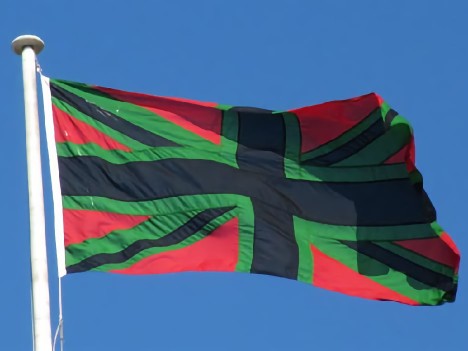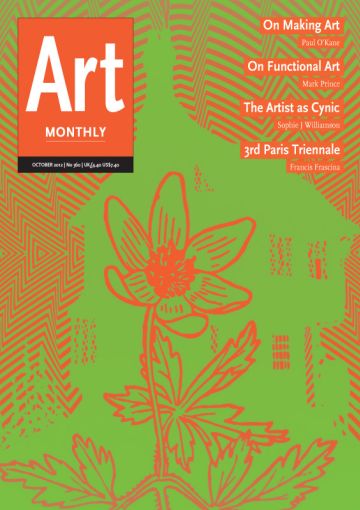Books
Eddie Chambers: Things Done Change
Richard Hylton on Eddie Chambers’s challenge to art institutions and their treatment of black British artists

Chris Ofili, Union Black, 2003, Tate Britain, London, 2010
In an article published to coincide with Chris Ofili’s retrospective at Tate Britain in 2010, Guardian art critic Adrian Searle claimed that: ‘Until the 1990s, there were hardly any black students at British art colleges. Ofili’s success showed that, if you have the intelligence, savvy and ambition, being an artist is a career option.’ While such a viewpoint has arguably become the norm in explaining the meteoric rise of black artists such as Ofili and for narrating the recent story of British art history, it also reflects a mindset that Eddie Chambers refers to as ‘a sort of Year Zero, taking no respectful account of whatever had gone before the mid to late 1990s’. This mindset has also, according to Chambers, been able to flourish because, for others still today, the 1980s was ‘the be-all and end-all of Black artists’ activity’. Things Done Change sets out to challenge such divergent and equally problematic attitudes while presenting an alternative view of recent art history.
At its core, Things Done Change – The Cultural Politics of Recent Black Artists in Britain ‘seeks to understand the ways in which both the construction and the perception of Black artists, Black images, and Black artists’ practice all changed markedly over a period of time’. The period under scrutiny primarily spans the early 1980s through to the early 2000s. Over five chapters, Chambers fashions an expansive critique that sheds new light on a broad range of black artistic practice and contextualises the varied fortunes of black artists in the UK.
Things Done Change draws on a substantial range of sources, including exhibitions, media and academia, to construct a meticulously researched and in-depth critique. In doing so, Chambers provides lucid insight into the changing values and tastes of the (UK) art world, which have themselves been influenced by the shifts that have taken place across the UK’s social, political and cultural landscape. In this regard, Chambers’s narrative calmly positions the work and activities of black artists in relation to this broader context. There are two interrelated reasons for this approach. Firstly, Chambers questions the assumed ‘objectivity’ of art criticism, asserting that ‘The bookshelves of this country’s university libraries contain no end of sloppy, partial, racially biased “white” scholarship that masquerades as objective canonical knowledge’; and secondly he expresses the view that ‘Black artists have been susceptible to being excised from all manner of narratives, even, ludicrously, their own’. Chapter headings appropriated from the political and cultural arena, such as ‘You were the future once’ and ‘Everything Crash’, function both literally and metaphorically, further illustrating Chambers’s commitment to placing his subject within a wider social context.
During the early 1980s the UK visual arts sector experienced a new and unprecedented level of artistic activity generated by the first generation of British-born black artists. The chapter ‘The only thing to look forward to… is the past’ explores how during the 1980s ‘arguments and opinions about Black artists’ practice were advanced, moulded, and contested, not only via the written and spoken word but also through curatorial initiatives’. By the early 1990s much of the promise and optimism of this generation had, for a number of reasons, including certain institutional indifference and hostility, steadily evaporated. While moderately successful artists such as Sonia Boyce and Keith Piper ‘entered a sort of functioning obscurity’, others, such as Simone Alexander, Amanda Holiday and Mowbray Odonkor, ‘melted away altogether’.
The chapter ‘Chris, Steve, and Yinka: We Run Tings’ provides a detailed analysis of this art triumvirate’s spectacular rise to success, which coincided with the emergence of the ‘yBas’, ‘Brit Art’ and ‘Cool Britannia’. Chambers also contemplates an intriguing aspect of their respective triumphs that has been hitherto rarely explored in art criticism: while the work of a wider body of contemporary black artists had come to be characterised as ‘overly political’, ‘angry’ and ‘confrontational’, partly because of the role black imagery played in their work, by contrast ‘Chris, Steve, and Yinka’ managed to ‘sidestep such debilitating and disengaged readings that earned them bouquets, and few brickbats, from white critics’, despite their respective work’s propensity for exploiting black imagery for all its worth. Chambers offers wider reasoning for Chris Ofili’s, Steve McQueen’s and Yinka Shonibare’s conspicuous success, beyond innate ‘talent’ and ‘ambition’, including how their work came to expediently embody aspects of New Labour’s inclusive agenda in which ‘difference was no longer a signifier of disaffection, prejudice and opposition’ but a ‘decorative motif of diversity’. While for ‘the best’ this meant ever more exhibition opportunities and media adulation, ‘the rest’ – now labelled, among other things, ‘Black and Minority Ethnic’ (BME) artists – had to simply make do with the comparatively meagre offerings of ‘cultural diversity’.
In ‘Service to Empire’, Chambers explores how increasing numbers of people, and black people in particular, have come to be honoured by the establishment by way of ‘gongs’. This apparent symbol of the UK’s ever-blossoming diversity, for Chambers, also illustrates the ‘profound political shifts’ made by black people in kindly accepting such honours. In the visual arts sector, such ‘developments’ assume an even greater level of irony, particularly when some of those being ‘honoured’ made their names in the art world with work which was, for all intents and purposes, diametrically opposed to all things empire.
In recent years there have been a number of sporadic attempts by institutions to revisit the work and history of earlier generations of black artists in the UK. Tate exhibitions such as ‘Afro Modern: Journeys Through the Black Atlantic’, 2010, and ‘Migrations: Journeys into British Art’, 2012, while laying claim to diversifying the ‘canon’, insist on presenting black artistic practice not only in an ostensibly quarantined form but also seemingly in lieu of engaging with the wider body of contemporary black artistic practice. In the light of such developments, Things Done Change can also be considered to be an important, if all too rare, counterpoint to prevailing institutional mindsets.
Eddie Chambers, Things Done Change: The Cultural Politics of Recent Black Artists in Britain, Rodopi, 2012, 299pp, £55, 978 9 0420344 3 3.
Richard Hylton is a freelance writer.
First published in Art Monthly 360: October 2012.









